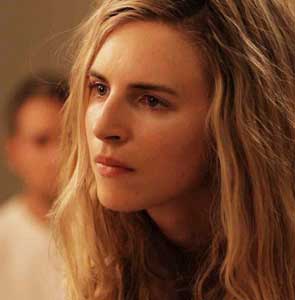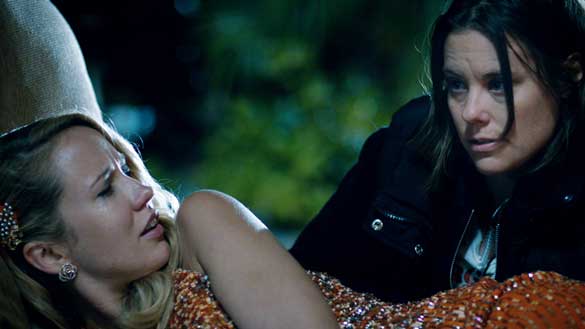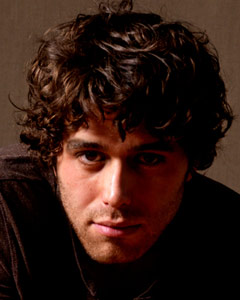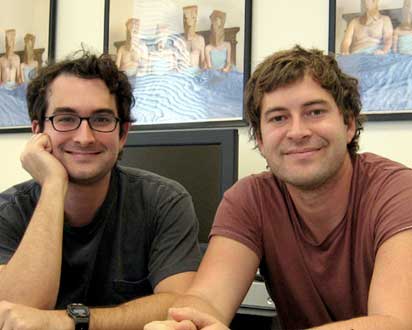If you haven’t been watching Chad, you’re missing out. Created by SNL-alum Nasim Pedrad, the show is about a 15-year-old boy named Chad Amani, who after finding popularity in season one, now finds it slipping away from him. He’s also got to deal with drifting away from his best friend and his crush to a new student from France. The show is hilarious and Pedrad, who’s also a writer, executive producer and co-showrunner, is wonderful.
In this interview, we chat about the show, how she transformed into a 15 year old boy and avoiding the “sophomore slump” for season two.
Season One and Season Two are both streaming on Roku now!
I’m so glad the show is back.
Nasim Pedrad: Me too. The fact that we finished editing it and a big merger happened definitely sent me into a panic. But luckily, Roku came in and saved the day, and the upside is now we’re in so many more homes than we were in before. So hopefully a whole new batch of people will get to discover this weird little show.
What was the thinking coming back for season two? You’re wanting to obviously top the last season, but also wanting to avoid that dreaded sophomore slump.
Nasim Pedrad: Oh my gosh, you hit the nail on the head. You want to be true to the character, but you also don’t want it to feel repetitive from what you’ve already seen in season one.
I tend to write from a very character driven place, and so when we were breaking the season in the writer’s room, we just thought, “Okay, well, how can we make him grow even in little ways that are believable so that this season feels fresh and new?” And we ended up giving him a little bit of a love story this season, which was really fun because it kind of gave the character a chance to fixate on something outside of himself.
Season one is so about him just desperately needing to be popular. He ultimately gets that at the end of season one for all the wrong reasons. And once that comes crashing down in the beginning of season two, he has to sort of rebuild and he has to reconcile with his cultural identity in a way that you don’t really get to see him do in season one. And then on top of all that, we gave him a love interest, which just ended up being so fun to shoot.
One of the things I really love about the show is there are kind of like these little asides where I burst out laughing when I hear them. Are those important for you to add those little nuggets in there because that’s one of the joys of the show, at least for me.
Nasim Pedrad: That’s so great to hear. Yeah, listen, comedy is obviously… It so comes down to sensibility and taste. And my specific sensibility I feel like has always been in the lane of nuance and not necessarily the most traditional setup punchline that you might see on other shows. As much as I appreciate that, I like living in that negative space at times in between the lines and mining, just the truth of a moment, however weird or uncomfortable it might be. And I think when the point view of the character is really clear, the comedy will come.
And so, it was really fun to play with that nuance and to find the idiosyncrasies of this character and to explore what it’s like for a kid with a very simple want, the desire to be popular, get in his own way episode after episode. And for me as a performer too, that kind of sensibility is just really fun to play.
You do almost everything on the show. You created it, you’re one of the writers, you’re now a co-show runner. I’m exhausted just like thinking about it. At the end of the season, were you just like, “I just wanna lay down and go to bed?
Nasim Pedrad: Yeah, it’s such an adrenaline rush to be in production, but that’s the kind of thing SNL really prepares you for. If you can survive the gauntlet of that schedule, you can sort of do anything you feel like coming out of it. So in comparison, everything tended to feel easy because we were never going to be live in an hour. You have the luxury of time and even if that time is only a day or a few hours, it still felt like an eternity compared to the instant gratification of SNL. It was definitely a train that didn’t stop, but a complete joy from the beginning.
And at that level, when you’re wearing these different hats, there’s just no way to pull it off without having an incredible army of people. And I had like three brilliant little armies from the writer’s room to production to editing of these crazy talented people that helped me pull it off. And obviously, I couldn’t have done it without them, but it was also so fun to collaborate and to get a wardrobe designers take on the character and the DPs take on the character, and we all kind of were this family that came together to bring this weird little vision to life.
Speaking of wardrobe, did you already have the voice, and the way he talks floating around in your head? Or did it happen once you had the costume and makeup and hair?
Nasim Pedrad: I think once I cracked the character in terms of what I thought it could be before embodying him, I started to, just for my own sake, improvise and find it from just playing around with it. This is obviously before any hair and makeup test, or any wig was designed. So, it started for me just kind of improvising and playing around. And then once it was up on its feet in a more professional capacity with these brilliant people that came on to design his eyebrows and his wig and figure out what kind of clothes he wears, it became how can we most sell me as a 14-year-old boy so that audiences are willing to suspend their disbelief enough to hopefully even just forget that a grown woman is playing him and take in the ridiculousness of it.
Those components coming together really landed the plane and made it so much easier to perform. Once I saw him, it was like, “Oh, I know what this is. It felt like it was less in the exploratory phase of when I first was trying to crack the character. So, it was a real evolution. The physical components for sure helped define the character as a performer.
If you were walking on set and you weren’t in costume right now, could you immediately get back in it? Or does it help when you have everything on?
Nasim Pedrad: I think I can sell it more when I have everything on, but there are times in my own life where I’ll say something and my friends will be like, “Oh my gosh, that was such a Chad moment.” And at the end of the day, there’s so much of him in me, how can there not be?
I think you said it yourself; you immediately forget that a grown woman is playing this character.
Nasim Pedrad: That was certainly the hope for no reason other than yes, there’s this conceit at the center of the show and this hook, but the show isn’t about that hook. It’s a coming-of-age story about a 14-year-old boy trying to navigate his high school experience. And so hopefully because there’s an adult playing that character, you could push the comedy further and there’s like a bit of a wink in that sense. But the goal was not to trick people into thinking I’m a little boy necessarily, or even to keep hinting that. It was really to disappear into the character and play it as earnestly as I could.




